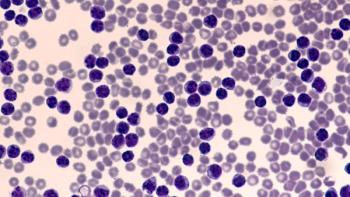
Optimizing Treatment for Patients with CLL
Dr Mahmoudjafari explores the role of BTK inhibitors in the treatment of CLL.
Zahra Mahmoudjafari, PharmD, BCOP, DPLA: Patients are typically stratified into 3 groups based on their functional status and the presence or absence of comorbidities. Patients 65 years or older, younger patients with significant comorbidities—for instance, creatinine clearance less than 70 mL/min—and patients less than 65 years of age without significant comorbidities. The typical indications to begin treatment include disease-related symptoms, progressive bone marrow failure, autoimmune anemia plus or minus thrombocytopenia that’s poorly responsive to other therapy, progressive splenomegaly, large or progressive lymphadenopathy, symptomatic or functional extranodal involvement, or progressive lymphocytosis with a greater than 50% increase over 2 months. At the end of the day, it’s critical to assess a patient’s symptoms and individualize treatment, taking the entire patient into account.
I’m not sure there’s an optimal approach. I think of it as more of an individualized approach looking at not only the disease severity of the patient but also their cytogenetics, their comorbidities, as well as the other medications the patient is taking. It’s also important to look at the potential adverse events with each treatment option and determine which 1 will be the safest while also the most efficacious.
Thankfully, we have some cross-trial comparisons [between Bruton tyrosine kinase (BTK) inhibitor monotherapy and BCL2 inhibitors]. We see that the 4-year progression-free survival rate for venetoclax plus obinutuzumab is similar to that reported for ibrutinib. However, the venetoclax-based regimens may be associated with a shorter median progression-free survival in patients with TP53 abnormalities and potentially those with IGHV-mutated disease. There are also pooled data from 4 trials of frontline ibrutinib that included patients with TP53-mutated and/or deletion 17p CLL [chronic lymphocytic leukemia]. Historical data suggest that patients who’ve received chemotherapy will live for approximately 2 to 3 years. But data from this analysis showed that at 4 years, nearly 80% of patients with CLL who had a TP53 mutation who received ibrutinib were progression-free, which is impressive.
Alternatively, the updated analysis of ELEVATE-TN showed a 4-year progression-free survival of approximately 75% with acalabrutinib, with or without obinutuzumab in patients with CLL who had deletion 17p and/or mutated TP53. With these data, I’d probably lean toward a BTK inhibitor for patients with mutated TP53. However, it’s not an absolute that the patients must receive a BTK inhibitor. If we have patients with factors that would make a BTK less desirable—for instance, if they have uncontrolled atrial fibrillation, a mechanical heart valve, and/or receiving warfarin—even if they have TP53-mutated CLL, we would consider venetoclax plus obinutuzumab. This also has great activity compared with immunotherapy for patients with CLL with deletion 17p and/or mutated TP53.
Venetoclax isn’t associated with toxicities that are characterized by BTK, but it has a higher rate of neutropenia. Febrile neutropenia occurs, although at a lower rate than you would see for other treatment regimens, but we see that a high grade of GI [gastrointestinal] toxicities can occur. It also carries the risk of tumor lysis syndrome in patients with high absolute lymphocyte counts or bulky tumors. We’re aware of it, and it’s typically manageable with hydration and appropriate prophylaxis.
Other factors to consider outside efficacy and safety when designing a treatment regimen are ease of initiation and the patient’s lifestyle. On 1 hand, BTK inhibitors can be started easily and quickly and don’t require a lot of clinic visits, whereas venetoclax plus obinutuzumab has a more intensive run. This comes into play with busy clinics, which can be a challenge operationally in light of the pandemic. One other important caveat for venetoclax and obinutuzumab is that this does deplete B cells substantially, and that has implications when it comes to our vaccines. As we know, these patients are at risk for recurrent infections.
You’d be hard-pressed [for answers] if I didn’t talk about the cost for both treatment options. The venetoclax plus obinutuzumab regimen does have a defined treatment duration of about 1 year, and we have follow-up data that most patients can remain off therapy beyond 3 years after completing venetoclax plus obinutuzumab. This comes with its own unique costs and challenges. In contrast with BTK inhibitors, these patients would take oral medication therapy indefinitely. Even though it has great long-term efficacy, this can be challenging for a patient if they have high co-pays. However, when we assess costs, when you compare venetoclax vs obinutuzumab against ibrutinib and other options, it could be better to have less cost with a finite-duration therapy.
Transcript edited for clarity.
Newsletter
Stay informed on drug updates, treatment guidelines, and pharmacy practice trends—subscribe to Pharmacy Times for weekly clinical insights.



















































































































































































































